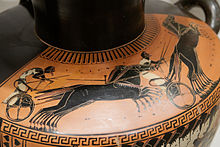Chariot races
Chariot racing was a popular sport in ancient Greece and Rome . In late Roman antiquity and in Byzantium , the supporters of different teams were divided into circus parties . Probably first the "Greens" and the "Blues", later the "Whites" and "Reds", who at times fought civil war-like battles. Under Domitian there were even six parties, gold and purple were added.
Chariot races were carried out with chariots , which were usually drawn by two (Greek: Synoris συνωρίς , Roman: Biga ) or four (Greek: Tethrippon τέθριππον , Roman Quadriga ) horses. Since when this driving sport has existed is unclear. The first literary mention can be found in the Iliad , which tells of a race in honor of Patroclus who fell in battle .
According to a legend, a chariot race won by bribes by Pelops was the reason for the first Olympic Games . In fact, it was only from 680 BC onwards. Chr. Chariot races held at the games. Unlike the other ancient Greek athletes, the charioteers weren't naked - they wore work clothes that were safe for the races. Powerful personalities from the Greek world - such as Philip II of Macedonia - had their own wagons compete at the Olympic Games. The aristocrat Kimon , who ran himself, was probably killed because of his success as a charioteer.
The Circus Maximus was built in Rome for the chariot races and the hippodrome in Constantinople . The Romans probably took over the custom from the Etruscans , who in turn may have had it from the Greeks. In contrast to the Greeks, the Roman charioteers ( agitatores ) did not hold the lines in their hands, but instead wrapped them around their arms. This gave them a better grip, but there was also the risk of being dragged along in the event of a collision, which apparently did not happen infrequently. So they had a knife with them to cut off the reins if necessary. In addition to frequent accidental collisions and carts being carried out of the curve, charioteers also hit each other, so they lived quite dangerously. The usually seven rounds was counted with dolphins, among other things, since the god of the sea, Neptune , was also considered the creator of the horses.
The chariot races were of great political importance in principle and in late antiquity , for example the Roman emperor often supported a party.
A famous chariot race in film history is that from Ben Hur . Today's forms of chariot racing are, in a greatly modified form, trotting or driving .
Web links
Individual evidence
- ↑ a b c Barbara F. McManus: THE CIRCUS: ROMAN CHARIOT RACING . July 2003, accessed July 19, 2019.
- ↑ a b c Ludwig Friedländer : Moral History of Rome - Chapter VIII . Reprint 1934, Phaidon Verlag Vienna.
- ↑ University of Mannheim , Chair of Ancient History (Ed.): Chariot racing with a two-team . accessed on July 19, 2019.
- ↑ Erwin Pollack : Bigae . In: Paulys Realencyclopadie der classischen Antiquity Science (RE). Volume III, 1, Stuttgart 1897, Col. 465-467.
- ↑ a b University of Mannheim , Chair of Ancient History (ed.): Chariot racing with a four-team . accessed on July 19, 2019.
- ↑ Paul Jonas Meier : Agones 2 . In: Paulys Realencyclopadie der classischen Antiquity Science (RE). Volume I, 1, Stuttgart 1893, Col. 836-867.
- ^ Chariot racing . In: britannica.com , accessed July 19, 2019.
- ↑ Per foul play into eternity . In: Spektrum.de August 19, 2016, accessed on July 19, 2019.
- ↑ Markus Weisenhorn: THE HIPPISH AGONS . In: Forum Archaeologiae , 2007, accessed July 19, 2019.
- ↑ Ulli Kulke : The old Olympia was as corrupt as Fifa . In: welt.de , June 8, 2015, accessed on July 20, 2019.
- ↑ Hippodrome . In: britannica.com , accessed July 19, 2019.
- ^ A b Elizabeth Rawson : Chariot Racing in the Roman Republic . In: Papers of the British School at Rome , November 1981, doi : 10.1017 / S0068246200008448 .
- ^ Paul Jonas Meier : Agitator . In: Paulys Realencyclopadie der classischen Antiquity Science (RE). Volume I, 1, Stuttgart 1893, Col. 822 f.
- ↑ Erwin Pollack : Delphines 2 . In: Paulys Realencyclopadie der classischen Antiquity Science (RE). Volume IV, 2, Stuttgart 1901, Col. 2510 f.
- ↑ Ben Hur: How dangerous were the chariot races of antiquity? . In: Wissen.de , September 5, 2016, accessed on July 19, 2019.


